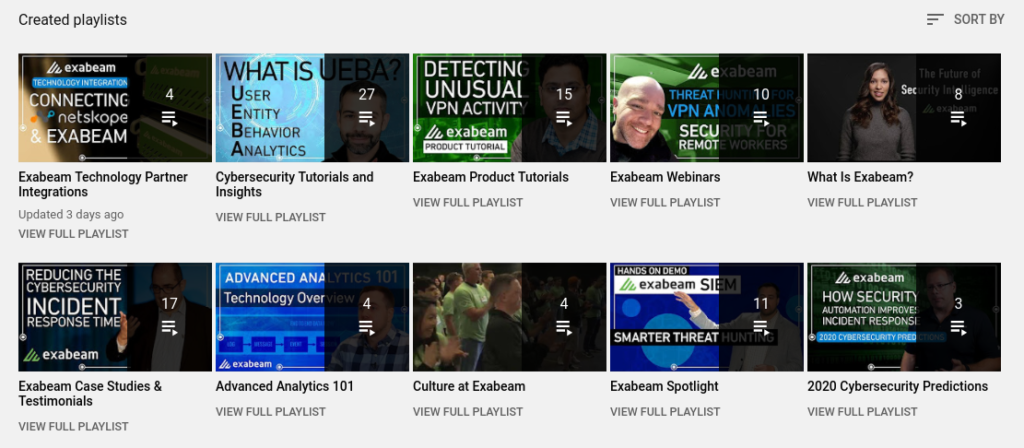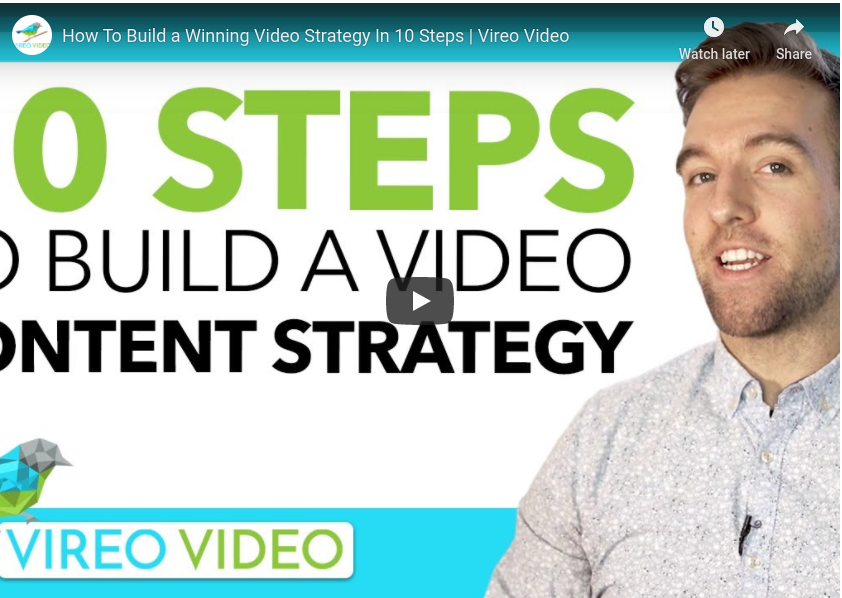What is Video Content Strategy?
Have you ever wondered why video is so effective?
With more and more product reviews and educational content existing on video-sharing platforms, the difference between good and bad video marketing strategy can either develop great sales and marketing channel or set you way behind your competitors.
Here at Vireo Video, we help online brands and influencers to grow their business and audience with video content and have helped brands generate over 2.5 billion views.
Video content strategy is one of the first things we create when starting to work with a new client and we want to share a few aspects to keep in mind when creating it yourself.
Video content strategy refers to how you approach creating videos in relation to your business goals.
Planning and executing your video strategy from start to finish, taking into account a variety of potential obstacles, is crucial in order to get the greatest return on investment (ROI).
When you take time to outline clear goals, expectations, tactics, and resources it is more likely that you will succeed.
Here are the 10 steps to build a winning video content strategy:
1. Set Your Goals
First, ask yourself these two questions to figure out your starting point to create a successful video strategy.
What is the goal of the channel or campaign?
What are you ultimately trying to achieve with video?
Seems simple enough right?
But the truth is, brands looking to enter the space or trying to improve on their existing strategy often do not have a clear set purpose in mind.
For example, the primary goal of your video content could be generating more clients for your business.
In this case, the content needs to be tailored appropriately to move prospects through the buyer journey, by first making them aware of you, but then continuing to nurture them until they’re ready to make a sale.
You could do this by providing your audience with valuable video content to increase the engagement with your brand, or link them to a free resource in exchange for their email, and warm up those leads.
If you have potential warm leads that are more likely to buy, focusing on creating testimonials or influencer compilation videos that could be remarketed to the potential leads, who recently visited your website, engaged in your content, or have been a buyer in the past.
Video is excellent at propelling prospects through your funnel.
On the other hand, if your main goal of video content is to increase brand awareness and garner a larger audience, you might increase the frequency of your videos and include a diverse range of topics to develop your audience.
Some brands we have worked with have wanted to improve their video and website SEO on YouTube and Google. For many channels, we see search traffic average around 30% of all video traffic sources.
Let’s take Bachelor on a Budget’s YouTube channel, for example, YouTube search traffic has been 45% of the total for 1 million views in the past year. Google Search has been 88,000.
If you want to rank for key search terms, you’ll want to create evergreen content based on some of the keywords you want to rank for. These evergreen videos are often how-to videos.
You may want all of these things, and your video content can serve multiple purposes. But regardless, having clear goals will allow you to focus your attention and resources.
2. Know Your Audience
Who is your ideal viewer or customer? (Demographics/Psychographics)
What does your audience watch and type into the YouTube Search Bar?
What communities do your videos align with?
Understanding your audience is crucial to a successful video campaign.
Every day, millions of videos are uploaded onto YouTube and other social channels.
If you do not clearly define your target audience, your content may be too diverse. Not only will you be facing an immense amount of competition but an uphill battle with the algorithms.
For the YouTube channel we mentioned earlier, a cooking show, the channel started the channel as Omnivore, teaching people how to make healthy delicious meals affordable.
But since running the channel, the diet of the host has transitioned to a plant-based one, and so has the channel.
So viewers that subscribe because of the Oven Roasted Ribs recipe video, are not as likely to click and watch through a video of Vegan Shepherds Pie video.
And that shows the algorithms that subscribers aren’t as interested in the topic, which will then limit the number of impressions the content gets.
Focus on a niche audience that you can serve.
After identifying the audience, focus on the behaviour of your viewers.
- What problems are they trying to solve
- What do they type into the search bar?
- Where do they find the content they are interested in?
Create a viewer profile to cater to your videos accordingly and target the right community to make the most out of the time invested in making your videos.
3. Unique Value Proposition
What unique value does your channel provide to your audience?
What are you an expert in that you can teach?
Now that you have your audience and their behaviours defined, think of what makes you different from everyone else in this space.
Why would a viewer choose to click to watch your video versus someone else’s video with a similar topic? In their head, it’s always “what’s in it for me?” and “Is this worth watching more?”.
For the channel we are discussing, the UVP is to teach people how to create healthy and delicious food that viewers can make with cheap ingredients, and ultimately save more money by eating at home more.
Having a differentiating factor makes it far easier to compel your audience to choose your content, watch more content and subscribe. And ultimately get them to go to your website to check out your products.
You’ll want to make sure your UVP is clear from when someone visits your channel or watches any video.
4. Create Themes or Series

Think: What series of content can you consistently produce?
Having consistent themes to your content will increase the chances that the viewer continues to watch one video after another, instead of going to a competitor.
This can be achieved by developing a series or playlists. Algorithms are also likely to reward you when you post similar content to videos you’ve already had success with.
Some themes are going to be easier for you to produce than others. I.e. videos that you already have content for such as your blog or FAQ are going to help you quickly produce valuable content.
For Bachelor on a Budget channel, there is content which is separated out into playlists such as Vegan Keto Recipes, Grocery Hauls, Breakfast Recipes, Dairy and Gluten Free etc.
5. Video Format
What formats can you consistently produce?
What formats will help you achieve your goals?
What formats get the best results in your niche?
Think of your video format as the different types of content you’ll create such as Tutorials, FAQ’s, Live Content, DIY, How-To, Social Advertisements, Mini Docs, Conversational etc (see above, an example from our client Macinhome – a playlist of listicles, how-to style videos).
You likely won’t have just one format and you’ll want to test out a few different types to see what you can produce consistently, and where you have the most success and return on investment (ROI).
Ensure that the video style matches with the audience’s preferences, but is also something you can create that doesn’t feel like a burden.
For Bachelor on a Budget, recipe videos are a lot easier to set up and film, than a video where I need to research the topic heavily and write out a script for it.
You’ll also want to look back to your goals here, and ask yourself, “Do these formats of content help me achieve my goals?”
Again, if your goal was to generate more organic search traffic, then how-to videos would be a great route.
You can also look to your competitors to see what video formats they have had success with.
This may be an indicator of the formats your similar audience consumes, even if your content is different.
6. Distribution

What platforms will you distribute your content through?
We largely have been focusing on YouTube in this blog, as that is our specialty, but your audience is likely on other social platforms, and can also find your content through other channels such as your email list.
You likely know where your audience is and pretty much all of the big platforms have native video now.
Therefore you can decide if you’re going to release content on one main platform such as YouTube, and distribute the link to other social channels, or upload your video content natively to each one your audience is on.
Social platforms prioritize natively uploaded video and YouTube links on Facebook likely won’t perform as well on Facebook.
But if your goal is to grow your YouTube channel, then YouTube likes to see external shares and new viewer sessions.
Figuring out which platforms you’ll distribute to, also streamlines the production of your content.
Filming your videos vertically is now not only socially acceptable, but can better utilize screens on certain platforms, and mobile devices.
7. Resources
What key equipment or resources do you have to produce great videos?
What equipment or resources do you need to produce or improve your video content?
Resources are always something to consider when planning your marketing strategy.
In this case, you are investing time and resources to tackle the video space, so understanding the manpower and cost behind the production is important.
At first glance, you might be thinking of a camera, lights, microphone or editing software.
However, a strong video with good retention may require other resources as well such as a studio or set, lighting, videographer, on-screen talent, strong editing prowess and much more.
Discover how your videos are formatted to estimate how long editing will take, and what equipment to use.
A five-minute video could take anywhere from 20 minutes to 8 hours to be completed – from filming to editing and post-production.
This will largely depend on the video type, skill sets of your team, and of course the resources you have available to you.
Therefore, taking into consideration these things beforehand can help you make an informed decision on what you need to execute on your video content strategy, and budgeting out the costs associated with producing it.
Fortunately, the costs of the tools to create amazing video content has come down drastically, so if you don’t have the budget to hire a fancy production company, and build a set in house, you can record great authentic content with your iPhone that can film in 4k and fancy AirPods.
8. Qualities
What qualities in your videos will your audience resonate with?
Similar to your unique value proposition, qualities refer to the ingredients that will lead your audience to addictively consume your content.
However, qualities are a little different, since it has more of a focus on the host’s qualities and the unique elements of how your content is presented or edited.
The qualities can range from being charismatic, humorous to being extremely informative and intelligent.
Ensure that the host is captivating in whatever aspect to encourage the viewer to watch more videos from you in the future.
Aside from the host themselves, the scripting and delivery is also integral to a successful video, and strong video strategy.
9. Promotion
Where will your videos be shared?
What publishers or influencers will share your content?
What paid media will you use to connect with new audiences?
Promotion can be looked at from two angles – organic and paid. Organic promotion can be instrumental in making a video campaign successful.
For paid promotion, this can include media buying channels such as YouTube Ads, Facebook/ Instagram Advertisements, or LinkedIn ads, or it could be paid PR campaigns, or leveraging influencers to promote your content.
For organic promotion, you want to identify where your audience’s communities are and be a valuable tribe member by providing great content, but also engaging back. This can be forums, Reddit, Facebook or LinkedIn Groups, Slack groups etc.
With all of these channels, you’ll want to be careful about too much self-promotion to avoid being seen and flagged as spam.
You can also give your audience reasons to share it.
You could do a contest giveaway rewarding viewers who share the video.
Or simply ask your audience to share by encouraging the mutual benefit everyone obtains when the valuable content is shared among the community.
If your video can elicit a strong emotional reaction, your audience will be compelled to share it with their friends and peers. That is how things go viral.
10. Collaboration
Who can you collaborate with?
What value can you provide to Collaborators?
Collaboration can be a number of things such as teaming up with another business or creator and creating content to distribute on one or each other’s channels, often with the purpose of leveraging new audiences or creating unique content.
The greatest strength in collaborating is the ability to reach new audiences with the built-in trust factor that each party has with their own audience.
You could collaborate with another business that has a similar audience but doesn’t directly compete with each other. If you work for an IT consulting firm, you could develop a webinar with a Software company that you service your customers with.
One of our clients, Hum Nutrition, regularly collaborates with health experts, such as nutritionists and fitness instructors to create unique content with expert insights. They also do unboxing videos of their monthly subscription box, which will often feature other companies’ products.
Working with influencers or aggregation channels that are passionate about your business and products can be very lucrative. If you can create or foster relationships with influencers or aggregation channels, then they are more inclined to share your content and/or product with their following or collaborate on a video at a reduced rate, or free.
In a successful collaboration, all parties should benefit, but most importantly is the audience you’re serving.
We have created a Video Content Strategy Canvas inspired by the Business Model Canvas developed and made famous by Strategizer. You can use this resource to map out these key elements of a successful video content strategy. You can download that here.



